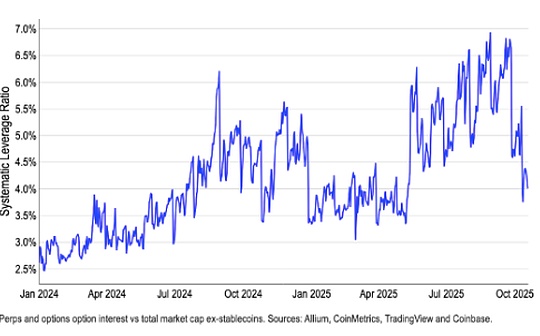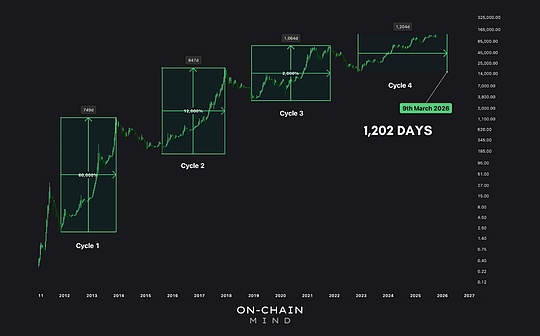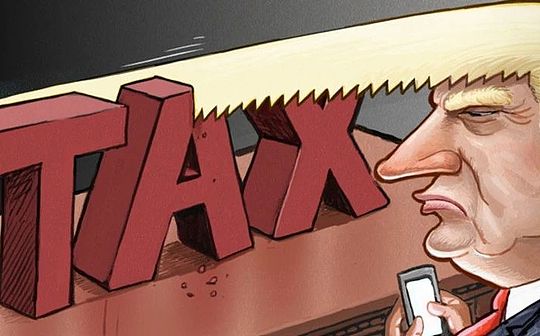
Source: The rich man’s surplus grain
With the clarity of the results of the House of Representatives’ election, the results of the 2024 US election have been revealed.According to the existing vote statistics, the Republican Party is very likely to win 219 House seats, thus locking in the majority.
In this way, the Republican Party not only swept the seven swing states, won the presidential election, but also locked the majority early in the Senate election. The latest results of the House election show that after Trump takes office, he will become a super power (All-powerful president) the president.
As early as Trump’s previous term (2017-2020), Trump appointed three conservative justices to the Supreme Court, which led to the total number of justices who tend to be Republicans reaching 6 (9 in the Supreme Court.Supreme Justice).This means that unlike other presidents, Trump can exert a significant impact on the judiciary during his second term.
Traditionally, the United States has five major power institutions – the President and Administration, the Senate, the House of Representatives, the Federal Reserve and the Supreme Court. Now there are four power institutions that agree with the Republican thinking in terms of philosophy (except the Federal Reserve, which has always claimed to be independent),It is extremely rare in American political history, which is why people are hotly debated that Trump will have “super power” after taking office.
Trump is about to enter the White House, and Trump transactions in the market are in full swing.
To sort out Trump’s economic commitments in the 2024 presidential campaign, we can roughly summarize them as follows:
1) Economic aspects: Promise to “end inflation”, promise low interest rates, so that Americans can afford their expenses again;
2) Taxation: propose tax cuts with a scale of trillions of dollars to expand the scale of tax cuts;
3) Immigration: Vow to block the border by building a wall and strengthening law enforcement, and launch the largest deportation operation in history against undocumented immigrants in the United States;
4) Trade: Take tariffs as the core commitment of the campaign, propose new tariffs of 10-20% on most foreign goods, 60% on all Chinese goods, and other tariffs on those countries that do not use the US dollar.;
5) Energy and environment: Committed to fully liberalize US crude oil extraction and eliminate environmental policies that limit carbon dioxide emissions;
6) Other commitments involving economy and assets: support for cryptocurrencies.
The framework on economic taxation and trade in Trump’s policy can be simply summarized as “three lows and one high”:
Low income tax, low interest rates, low inflation, high tariffs.
Next, I will divide it into several articles to discuss whether there is any possibility of realization of these three lows and one highs.

Let’s talk about the income tax situation first.
On the last day of October, the US election was entering its final sprint stage. Trump came to the Capitol Hill Club and took the time to hold a closed-door meeting with some Republican lawmakers. He proposed a way to make everyone die.A shocking idea – if we are elected president, we might as well exempt all the federal income tax!
Wow, Li Zicheng has been dead for 380 years. A commander of American imperialism actually shouted that slogan again—
When King Chuan comes, he will not pay taxes (King Bian will not pay grain when King Chuan comes).
Li Zicheng was just shouting at the time to seize the Ming Dynasty regime, but now the “King of Sichuan” who has been elected as the president of the United States really planned to do this in his heart!
As we all know, the fuse that triggered the American independence incident was that the British government decided to impose taxes on colonists, so the American people have always had a profound resistance to various taxes. It is generally believed that taxes were committed by the government to maintain its own operations.a kind of evil deed.
Income taxes that are directly taxed on corporate and personal income have made every public feel even more painful. Therefore, from the founding of the United States to the outbreak of the Civil War, there was no income tax as a tax at the federal government level, and the US Constitution did not mention it at all.When it comes to taxation, Americans naturally think that they do not need to pay income tax.
It’s really not!
At that time, in the United States, whether it is a business or an individual, as long as you have the ability to make money, it is all your own. You don’t have to pay taxes to the federal government, and you don’t have to pay a penny.
Regarding how the federal government survived at that time, we will talk about it later. Let’s discuss the income tax issue here first.
After the Civil War broke out, in order to fight against the rebellion in the southern states, the Lincoln government emptied its wallets and did not have enough military expenditures. What should we do?Only tax the income of enterprises and individuals.
Therefore, the Lincoln government promulgated the first federal income tax law in 1861 and began to collect income tax.
However, because the American people are generally unfamiliar with and do not accept this taxation, it is generally believed that this is a temporary measure during the war. A few years after the end of the Civil War, the Supreme Court ruled that income tax was “unconstitutional” and the government could no longerIncome tax was collected.
However, the government always had a way to expand its power. In 1894, the United States promulgated the corporate income tax law again, but soon someone sued the federal government for “unconstitutional”. The Supreme Court also ruled that the plaintiff won, so the tax was naturallyIt’s yellow again.
To impose income tax, the US Constitution must be amended!
In July 1909, a member of Congress proposed a proposal to amend the Constitution and allow the federal Congress to collect income tax. The proposal was approved by a sufficient number of states on February 3, 1913. This is the 16th chapter of the famous US Constitution.Amendment: “Parliament has the right to impose income tax on income from any source, and income tax revenue does not have to be distributed to states, nor does it have to be based on any census or scrutiny.”
In other words, before 1909, the United States had no corporate income tax or personal income tax.
Until 1909, the federal government was first allowed to collect income tax on enterprises, which was the beginning of the contemporary American income tax, but the tax rate was extremely low at the beginning, only about 1.5%.
By the eve of World War I, the federal government considered participating in World War I, and the corporate income tax rate rose to about 10%.
Before and after the United States participated in World War II, in order to deal with the war, the legal tax rate of corporate income tax was quickly increased to 40%. After the end of World War II, in order to compete with the Soviet Union for world dominance, the legal tax rate of corporate income tax was further increased to more than 50%.This statutory high tax rate continued until the Reagan administration and was significantly reduced.
Since then, the US corporate income tax rate has basically remained at 35%, until Trump came to power in 2017. The Tax Cut and Employment Act passed that year reduced the statutory tax rate of US federal companies to 21%. After the Biden administration came to power, it has lowered the tax rate of US federal companies.I dare not raise the tax rate, and this low tax rate has been maintained to this day.
It is worth mentioning that after the federal government collects income tax, more than 80% of state governments will also impose corporate income tax on enterprises registered locally based on the federal concept and definition of income, with a tax rate ranging from 1% to 12%..
The chart below is the legal and actual effective tax rate of corporate income tax at the federal level in the United States since 1909 (comparison of corporate income tax amounts and total corporate profits in the United States).
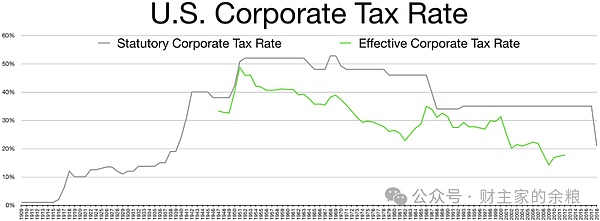
Source: U.S. Treasury Department.
In addition to corporate income tax, more importantly, personal income tax is personal income tax. Because taxes are imposed on individuals, everyone’s income situation needs to be accurately grasped, so the collection of this tax is more complicated.
After the 16th Amendment to the Constitution in 1913, the federal government began to tax individual income, and at that time the ladder tax rate had been determined:
For people with annual income less than US$20,000, the applicable tax rate is 1%;
Annual income of US$20,000-50,000, with a partial tax rate of 2% over US$20,000;
Annual income of US$20,000-50,000, with a partial tax rate of 2% over US$20,000;
Annual income is US$50,000-75,000, with a partial tax rate of 3% over US$50,000;
Annual income is US$75,000-100,000, with a partial tax rate of 4% over US$75,000;
Annual income of US$100,000-250,000, with a partial tax rate of 5% over US$100,000;
Annual income of US$250,000-500,000, with a partial tax rate of 6% over US$250,000;
Annual income exceeds US$500,000, exceeding some applicable tax rates of 7%.
It was from 1913 that any American could just say to government officials with confidence, “I am a taxpayer”, “We support you”, “You serve us”…
In the past 100 years, the applicable tax rate for personal income tax has changed greatly.
The lowest marginal tax rate for the highest income group was 7% in 1913, while the highest was 94% during World War II, and it is currently 37%; the lowest tax rate for the lowest income group was also1% in 1913, but has remained stable at 10% since 2000.
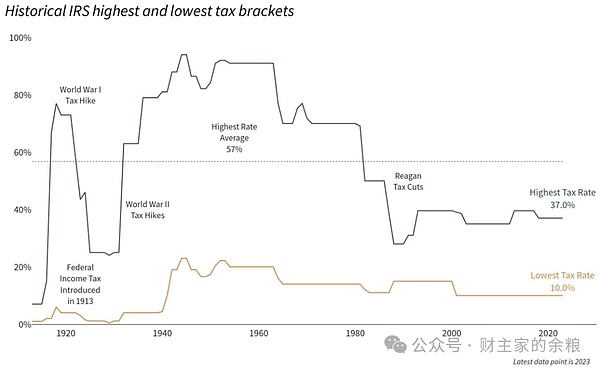
Source: U.S. Treasury Department.
It is precisely because since 1913 that income has been taxed by the federal government that Americans like to say: Only death and taxation are inevitable.
By observing the charts of corporate income tax rates and personal income tax rates in the history of the United States, we can find that both tax rates are currently basically at the lowest level since the outbreak of World War II and there is no room for much decline at all.
Well, we need to ask further, what is the proportion of income tax to federal income now?
The chart below distinguishes the proportion of various incomes of the US federal government from 1934 to 2017 – in the figure, Excise Tax is consumption tax, Payroll Tax is social security tax, and there are other taxes, which do not belong to income tax.

Obviously, income taxes from companies and individuals account for about 60% of the total U.S. federal government revenue.
In the just-passed fiscal year 2024 (October 1, 2023 to September 30, 2024), the total federal government revenue was US$4.92 trillion, of which personal income tax revenue was as high as US$2.43 trillion, accounting for nearly 50%; in addition,There is also a corporate income tax of US$530 billion, accounting for about 11%.

In theory, Trump can certainly reduce the current 21% corporate income tax rate to 0, or reduce the minimum marginal income tax rate to 0 in individuals, which means that the federal government’s annual income will be reduced by more than 60% immediately..
That means whether the US federal government will survive?Can we save $3 trillion in social security, medical care, national defense, treasury bond interest, unemployment benefits, veterans’ fees, education, transportation…?
What’s more, the federal government has been unable to make ends meet. It has been consuming more than 20 years. It has earned 4.92 trillion yuan in the past year, but it has spent 6.75 trillion yuan and an additional 1.83 trillion US dollars. In this case, Trump has to directlyGive up this $3 trillion income-
Do you want America to be great again?
This makes the United States small again!
Going further, from the perspective of specific implementation, it is okay to lower corporate income tax, but everyone is happy anyway, but if you want to lower the personal income tax rate of the rich, this is under the current public opinion of the United States, especially those who support Trump.It is probably a bit difficult in the minds of the red-neck voters who came to power.
According to research by Saez and Zucman and others, one-tenth of the wealthy people at the top of the United States account for 10% of the total wealth of the United States, while the taxes they pay account for less than 5%, which itselfIt has already made most American people quite jealous. How could Trump dare to take the blame for the world and continue to reduce taxes for the rich?
In the 2017 tax cuts led by the Trump administration, the corporate statutory income tax was greatly reduced from 35% to 21%, but in terms of personal income tax, it only dared to reduce the highest marginal income tax rate for the rich from 39.6% to 39.6% to37%, and maintain a marginal tax rate of 10% for ordinary people.
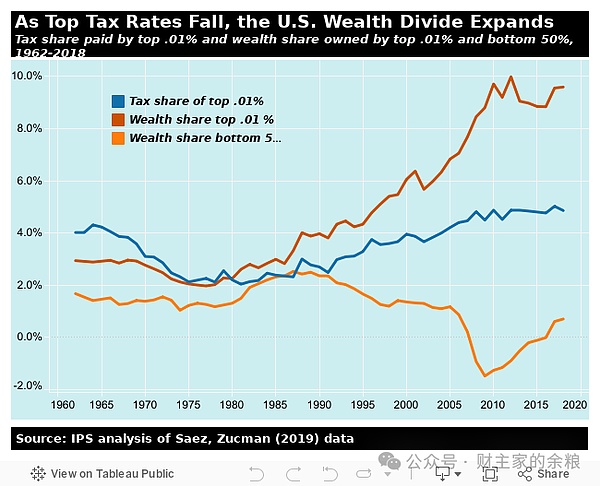
Not to mention the tax amount, if considering the collection of all income taxes, since Trump’s tax cuts in 2017, the effective tax rate of 400 super rich people in the United States has been lower than the people at the bottom of the wealth 50%. If Trump dares to give the wealth againPeople’s already extremely low marginal tax rates are reduced. Do you see if Americans want to get up with guns and kill the new Trump King?
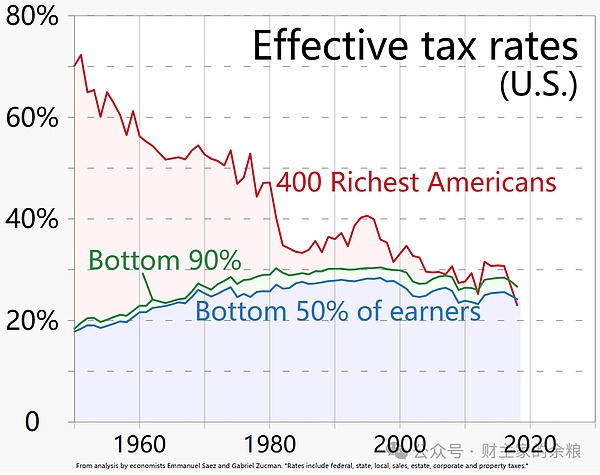
So, thinking about completely abolishing income tax, I can only say that Trump thinks beautifully!
That feeling was like I thought, with my ability to understand wealth, I should have a position on the Forbes rankings!







